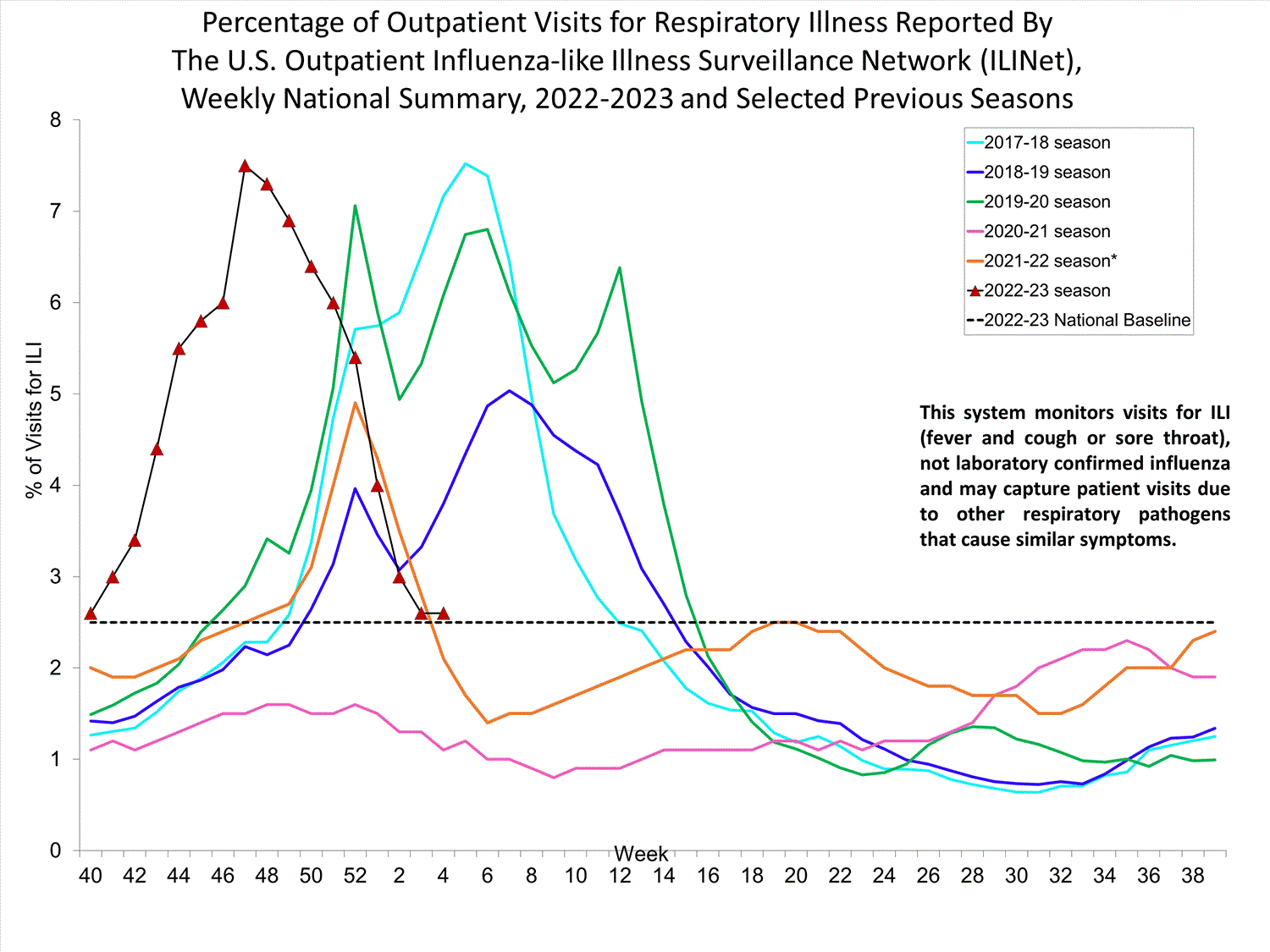The 2022-23 cold & flu season is notable, thus far, for its unparalleled unpredictability that placed an increased burden on the healthcare system, schools, and businesses.

Overview of the 2022-2023 Influenza Season So Far
The 2022-23 influenza season is notable for several anomalies compared to recent years.
- The season started earlier than usual.
- The percentage of outpatient cases exceeded those reported in 2017-18--one of the worst seasons in recent memory.
- The season appears to have spiked weeks earlier than normal, causing concern there may be a second wave.
The unexpected early and severe season combined with relaxed post-pandemic restrictions, low vaccination rates, a rise in RSV and COVID-variant cases, and a comparatively low influenza anti-body level due, in part, to two consecutive, extremely mild cold and flu seasons.
The Impact of the 2022-23 Flu Season
The most up-to-date influenza data from the U.S. Centers for Disease Control and Prevention (CDC) show that the spread of influenza has dropped to baseline. All significant data points are trending downward, including reported infection, hospitalization, and mortality rates.
However, due to the unexpected and early severity of the season, a significant burden has been placed on an already overtaxed healthcare system and economy.
According to estimates from the CDC, to date, the 2022-23 influenza season has resulted in the following:
- 25-49 million illnesses.
- 12-23 million influenza-related medical visits.
- 280,000-600,000 influenza hospitalizations, and;
- 17,000-53,000 deaths.
Further, while the total economic impact of the 2022-23 influenza season will take months, if not years, to tabulate, previous studies set the average financial burden, as of 2015, in the tens of billions of dollars range.
According to the U.S. National Institutes of Health (NIH);
The estimated average annual total economic burden of influenza to the healthcare system and society was $11.2 billion ($6.3-$25.3 billion).
Direct medical costs were estimated to be $3.2 billion ($1.5-$11.7 billion) and indirect costs $8.0 billion ($4.8-$13.6 billion).
These total costs were based on the estimated average numbers of (1) ill-non medically attended patients (21.6 million), (2) office-based outpatient visits (3.7 million), (3) emergency department visit (0.65 million) (4) hospitalizations (247.0 thousand), (5) deaths (36.3 thousand) and (6) days of productivity lost (20.1 million).
Lessons Learned from the 2022-23 Flu Season So Far
So far, the 2022-23 flu season has been marred by unexpected and unseasonal spikes in influenza and RSV, both of which are respiratory pathogens that primarily spread through direct and indirect contact, underscoring the need for intervention strategies consisting of:
- Daily enhanced cleaning of occupied facility spaces.
- Targeted disinfection of high-contact fomites.
- Daily disinfection of high-risk facility areas, including restrooms, cafeterias, and classrooms.
- Improved hand-hygiene compliance levels.
- Ongoing occupant health guidance in the form of signs, flyers, and emails.
The strategies, including vaccination recommendations for vulnerable demographics, are designed to prevent larger-scale outbreaks where the use of social distancing and lockdown requirements may be employed to arrest epidemic-level transmission.
According to the NIH;
Respiratory diseases may be reduced through reasonable and inexpensive hygiene efforts such as hand washing and using masks.
Although few data are available to assess the effects of community-level respiratory disease mitigation strategies (e.g., closing schools, avoiding mass gatherings) on reducing influenza virus transmission review of interventions used in past pandemics, modeling, and common sense indicate that these strategies may be our most effective mitigation tools.
For these strategies to be improved, additional research is needed to better understand how influenza is transmitted and determine the most effective strategies for reducing that transmission.
A Primer on Strategies for Prevention and Control of Seasonal and Pandemic Influenza
References
- 2022-2023 Influenza Season Looks to Be Severe
- Lessons Learned from the 2022-23 Flu Season
- Weekly U.S. Influenza Surveillance Report
- 2022-2023 U.S. Flu Season: Preliminary In-Season Burden Estimates
Takeaway
The 2022-23 flu season:
- Started early.
- Resulted in unprecedented infections and hospitalizations.
- Was compounded by unexpected Strep, RSV, and COVID-variant infections.
- Cost the U.S. economy tens of billions of dollars.
- May not be done yet.
The data shows an increasing irregularity to the cold and flu season, which tends to increase the severity and negative outcomes.
Preemptive intervention strategies, including enhanced cleaning and disinfection combined with socially responsible handwashing practices, can make the difference between an average cold and flu season and expensive school and business closures due to lockdowns.
Onboarding and managing the requisite labor and material resources necessary to ensure the highest standards of cleanliness are achieved and maintained may prove cost-prohibitive for many organizations.
Outsourcing is a proven method for onboarding highly in-demand cleaning and disinfection services and experience for a fraction of the price of maintaining a similar service in-house.
If you would like more information regarding the effectiveness of high-performance infection prevention and control measures, or if you would like to schedule a free, no-obligation on-site assessment of your facility's custodial needs, contact us today for a free quote!
In Bakersfield, CA, call (661) 437-3253
In Fresno, CA, call (559) 206-1059
In Valencia, CA, or Santa Clarita, CA, call (661) 437-3253
In Palmdale, CA, or Lancaster, CA, call (661) 371-4756



You must be logged in to post a comment.